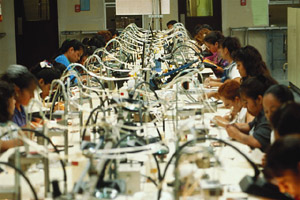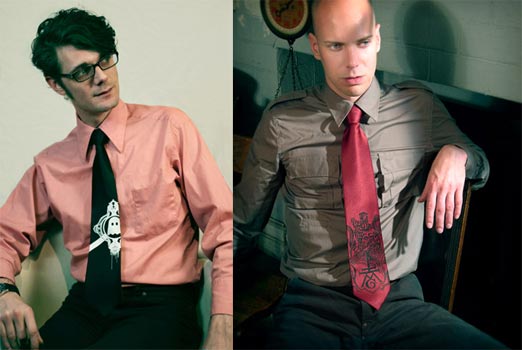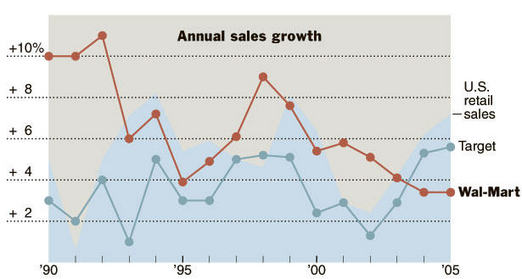With the Gap embarrassed this week by reports that Indian children as young as 10 were making Gap Kids clothing, a lot of people are asking, just how frequently and to what degree do large U.S. companies like Gap and Wal-Mart monitor their foreign manufacturers? According to Slate, “anywhere from six months to once every several years.” Unfortunately, because the visits are usually announced ahead of time, factories can hide violations, coach employees on what to say, get rid of the child workers, and forge records. In China, there are consultants who will prepare a factory for inspection, going so far as to fake missing records.
clothing

Amy Poehler And Will Arnett Attempt To Save The Gap
According to OK! magazine, Amy Poehler of Saturday Night Live and husband, Will Arnett, from Arrested Development are the latest celebrities to attempt to save the GAP by wearing its clothing in advertisements.

Tommy Hilfiger Only Available At Macy's
Macy’s and designer Tommy Hilfiger have reached a deal that will make the store Hilfiger’s exclusive “department store” retailer.

Target To Offer David Bowie Themed Clothes. Sadly, No Sequined Jumpsuits, Not Designed By Bowie
“British musician-turned-designer Keanan Duffty” has designed a line of David Bowie-themed mens wear for Target, according to a press release that reads like an acceptance speech:

Southwest (Finally) Apologizes To Mini-Skirted Customer
Southwest Airlines has finally condescended to apologize to the mini-skirted customer that it tried to kick off a flight…

New Zealand TV Program Says Chinese-Made Children's Clothes Are Contaminated With Formaldehyde
The New Zealand Ministry of Consumer Affairs is investigating claims made by a New Zealand television program that Chinese-made children’s clothes are contaminated with formaldehyde. The consumer watchdog program tested woolen and cotton clothes after receiving a complaint that a child had suffered an allergic reaction.

Dear New Gap CEO: Here's How To Fix Your Stores
A while back we asked the readers to tell us what was wrong with Gap, INC. Since we asked, they’ve sh*tcanned their CEO, closed a chain of stores, launched new ad campaigns featuring celebrities, rethought their merchandise and…nothing has has helped.

Shoppers Hate Skinny Jeans: Walmart Apparel Chief Resigns
Let’s face it. Your average body-type does not look good in tapered-leg skinny jeans. We’re not even saying “average body type” as code for “fatty.” We actually mean it. Regular people look bad in these fashions and do not want to purchase cheap Walmart versions of them. People want to buy socks at Walmart. Big bags of socks.
The Bikini's Tumultuous History
Bikinis were not always fit for toddlers; though they were accepted by the ancient Romans, bikinis made waves when they first appeared on the modern market, according to a slideshow essay from Slate:
- “When the bikini first arrived, its revealing cut scandalized even the French fashion models who were supposed to wear it; they refused, and the original designer had to enlist a stripper instead.”

String Bikinis: Now Available for Toddlers!
GapKids recently featured a white, crocheted string bikini you’d likely see Anna Kournikova wearing on the cover of the Sports Illustrated swimsuit issue. The bikini was for a 12-month-old.

How To Unshrink Wool
It’s actually very easy to unshrink a wool garment you shrank in the wash.
Clothing Makers Sue The Government Over Gender-Based Tariffs
Several clothing makers, including Steve Madden, Asics and Columbia Sportswear are suing the government over discriminatory gender-based tariffs. For example, Congress levies a 28% tariff on men’s bathing suits, but only a 12% tariff on women’s bathing suits.
If the clothing companies prevail, they could reclaim close to $1 billion worth of tariffs based on gender differences. For example, the lawsuit claims that the government earned $2.5 million last year from discriminatory tariffs on underpants (penalizing women), $93 million for cotton shirts (penalizing men), $16 million for silk shirts (penalizing women) and $71 million for shoes with leather tops (women again).
Tariffs are the quiet cousin of taxes; you seldom see a charge for tariffs, though they are factored into the cost of a wide array items manufactured overseas. To make the suit moot, the government may equalize tariffs at the higher level, which would hurt clothing makers and consumers alike. — CAREY GREENBERG-BERGER
More Crap About The GAP
Pressler’s penny-pinching may have turned off the Gap’s core customers. Sweaters that were once 100% cotton or wool, for example, showed up in stores as acrylic blends, and people noticed. Banana Republic tried to woo the same high-end consumers as J. Crew but didn’t go far enough in offering luxury fabrics, like cashmere, that those shoppers wanted. In 2005, while department stores couldn’t sell enough $100-plus premium jeans, the Gap skipped denim and tried to push khakis. “Pressler went too far in focusing on costs at the expense of merchandising,” says Christine Chen, senior research analyst at Pacific Growth Equities. “Sometimes you just need to go with your gut and do what makes sense to get customers in the door.”
The article also mentions the way in which stores like H&M refresh their looks faster, drawing in and keeping customers in their 20s and 30s. By the time a look hits the GAP, it’s already over, and possibly expensive for the store and unflattering for the customer (skinny jeans?)—MEGHANN MARCO

Like.com Finds What You Like
Like.com is a brand-new search engine that allows you to search by looking at shoes and accessories featured in celebrity photos. Sounds lame, and it is, until you realize that you can draw a box around the exact part of the featured accessory you like… and like.com searches for other products that have that same feature.





